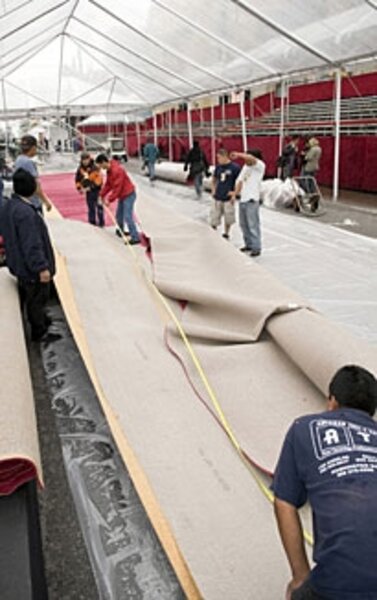Hollywood rolls out the green carpet
Loading...
| Los Angeles
America’s dream factory is out to put its reputation for waste in the can.
With a huge carbon footprint, and possibly more influence than any other industry, big TV networks and movie studios are partnering with major environmental organizations to go green. A growing list of behaviors once cutting-edge such as recycling, composting, and using wind, solar, and alternative fuels have become commonplace in Hollywood.
Not just season shows but high-profile awards events – such as the coming Golden Globes on Jan. 11 and the Oscars in February – are increasingly incorporating green ideas. These include red carpets made of old plastic bottles, chalkboards for signage, electric generators powered by soy waste biodiesel fuel, and party tents lit by solar panels. Gift bags at award shows now often include items such as low-energy light bulbs.
Such practices seemed faddish just a few years ago, but gained currency with the 2006 release of Al Gore’s Oscar-winning film on global warming, “An Inconvenient Truth.”
By using more renewable energy, the 2008 Oscars avoided an estimated 630 metric tons of carbon dioxide emissions.
“A year ago these practices were fad driven and everyone was just talking, ‘How do we do it, how do we go green?’ ” says Charisse McAuliffe, founder and CEO of Gen Green, a Colorado-based company which helps promote environmentally conscious lifestyles.
“This year a lot more companies have implemented what they were talking about last year. They are in execution mode. I think Hollywood gets it, and they understand their power that they can help others to get it.”
Green practices becoming the norm
More productions are including serious environmental goals in their mission statements. Fox Broadcasting Company adopted the slogan, “Green it. Mean it,” with the goal of becoming carbon neutral by 2010.
The company has taken the lead in greening large special events. It reduced the power needs for lighting at the 2007 Emmys by 75 percent, using low-wattage LED and fluorescent lighting in the press tent and solar panels to drive air conditioning. It also turned the 2008 American Idol Finale into a zero-waste event by composting organic materials and recycling bottles, cans, metals, and cardboard.
Fox has now created a comprehensive online handbook on environmentally conscious productions and events, which includes a worldwide “green” vendor guide.
“This cross-fertilization of ideas is very important at this early stage,” says Sasha Mervyn, director of development for Laura Ziskin Productions. She was asked to head the greening of the Oscars two years ago and recalls that she pretty much had to “start from scratch.”
The growing list of environmentally friendly practices shows that the town is doing more than just talking about responsibility, say observers.
“Hollywood is taking great effort to go green,” says Zahava Stroud, president and cofounder of iHollywood Forum, which organized an environmental conference this month for networks and movie producers. The impetus, he adds, is “coming from the top CEOs down.”
Ninety-five percent of the new green practices are not noticed by viewers and audiences, says Allen Hershkowitz, senior scientist at the Natural Resources Defense Council (NRDC) and ecological adviser to ABC, Sony, Warner, Capitol Records, and others. “The reduced ecological impact happens at the raw material acquisition stage and in processing, refining and transportation stages,” he says.
What may have an impact, however, is when announcers mention the activities on camera – such as Leonardo DiCaprio and Al Gore did at the 79th Oscar telecast in 2007.
“Hollywood is among the most culturally influential institutions on the planet so the impact is twofold,” says Mr. Hershkowitz. “One [impact] is the amount of energy and waste saved, the other is the message it sends to consumers and other industries.”
New techniques
Key individuals have made a difference in the Hollywood greening movement. Oscar-winning director Peter Jackson broke new ground when he used videoconferencing while filming the “Lord of the Rings” trilogy in New Zealand. It enabled him to remain in a central location while filming all three installments simultaneously. By plugging off-location cameras into the conference system, Jackson could make changes in lighting and camera angles from afar, saving air-travel emissions.
Jackson’s techniques are now must-haves used by other industry leaders from Lucas Film to Disney and Bad Robot Productions.
Hurdles remain for Hollywood’s new green agenda. Besides habit, there are technical and economic challenges, not to mention unfamiliarity with new products, materials, and processes.
But more and more studios have assigned “green gurus” known as EVPs or VP of environment, says Meredith Bergmann, spokeswoman for Green Media Solutions, a company that brings together environmental experts and production consultants.
What is helping drive each new advance is the realization that money can be saved, she says.
“If you reduce the number of cases of bottled water bought, reduce the number of locations, use less gas by renting hybrid vehicles, reduce the ... charter flights, you will save money,” says Ms. Bergmann. “It is getting more attention now that we see how costly – both economically and healthwise – neglecting the environment can become.”





